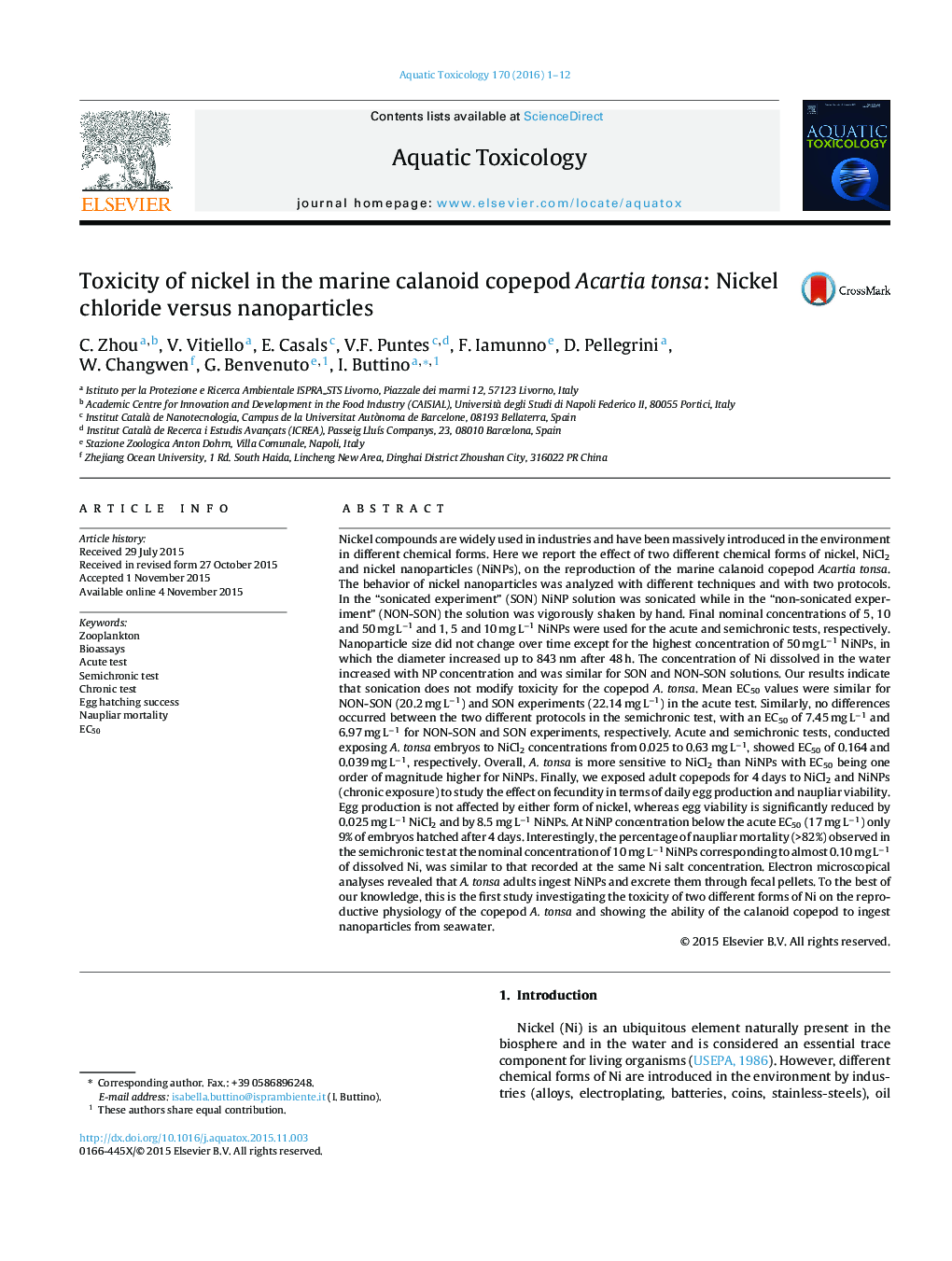| کد مقاله | کد نشریه | سال انتشار | مقاله انگلیسی | نسخه تمام متن |
|---|---|---|---|---|
| 4528961 | 1625935 | 2016 | 12 صفحه PDF | دانلود رایگان |

• Acartia tonsa copepod is more sensitive to NiCl2 than to nickel nanoparticles.
• At the tested concentration egg production was not affected by both form of nickel.
• Egg viability is the most sensitive end-point for both form of nickel.
• Nickel dissolved in seawater increased with nanoparticle concentration.
• Acartia tonsa adults were able to ingest nanoparticles.
Nickel compounds are widely used in industries and have been massively introduced in the environment in different chemical forms. Here we report the effect of two different chemical forms of nickel, NiCl2 and nickel nanoparticles (NiNPs), on the reproduction of the marine calanoid copepod Acartia tonsa. The behavior of nickel nanoparticles was analyzed with different techniques and with two protocols. In the “sonicated experiment” (SON) NiNP solution was sonicated while in the “non-sonicated experiment” (NON-SON) the solution was vigorously shaken by hand. Final nominal concentrations of 5, 10 and 50 mg L−1 and 1, 5 and 10 mg L−1 NiNPs were used for the acute and semichronic tests, respectively. Nanoparticle size did not change over time except for the highest concentration of 50 mg L−1 NiNPs, in which the diameter increased up to 843 nm after 48 h. The concentration of Ni dissolved in the water increased with NP concentration and was similar for SON and NON-SON solutions. Our results indicate that sonication does not modify toxicity for the copepod A. tonsa. Mean EC50 values were similar for NON-SON (20.2 mg L−1) and SON experiments (22.14 mg L−1) in the acute test. Similarly, no differences occurred between the two different protocols in the semichronic test, with an EC50 of 7.45 mg L−1 and 6.97 mg L−1 for NON-SON and SON experiments, respectively. Acute and semichronic tests, conducted exposing A. tonsa embryos to NiCl2 concentrations from 0.025 to 0.63 mg L−1, showed EC50 of 0.164 and 0.039 mg L−1, respectively. Overall, A. tonsa is more sensitive to NiCl2 than NiNPs with EC50 being one order of magnitude higher for NiNPs. Finally, we exposed adult copepods for 4 days to NiCl2 and NiNPs (chronic exposure) to study the effect on fecundity in terms of daily egg production and naupliar viability. Egg production is not affected by either form of nickel, whereas egg viability is significantly reduced by 0.025 mg L−1 NiCl2 and by 8.5 mg L−1 NiNPs. At NiNP concentration below the acute EC50 (17 mg L−1) only 9% of embryos hatched after 4 days. Interestingly, the percentage of naupliar mortality (>82%) observed in the semichronic test at the nominal concentration of 10 mg L−1 NiNPs corresponding to almost 0.10 mg L−1 of dissolved Ni, was similar to that recorded at the same Ni salt concentration. Electron microscopical analyses revealed that A. tonsa adults ingest NiNPs and excrete them through fecal pellets. To the best of our knowledge, this is the first study investigating the toxicity of two different forms of Ni on the reproductive physiology of the copepod A. tonsa and showing the ability of the calanoid copepod to ingest nanoparticles from seawater.
Journal: Aquatic Toxicology - Volume 170, January 2016, Pages 1–12